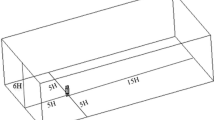Abstract
This study examines deviations in peak pressures among different facets of a ‘Z’ shaped building model tested using numerical simulation technique. Peak suction and pressure for each face and the variation of gust factor (GF) along the vertical centerline of different walls of the parametric model corresponding to 0° and 90° wind angle are presented. For this purpose, the unsteady Reynolds Averaged Navier–Stokes (URANS) Computational Fluid Dynamics (CFD) simulation tool with the k-ε turbulence model is adopted. The geometric scale is taken as 1:300 and the velocity scale is 1:5. Contour plots showing changes of peak pressure at different locations of each face are also presented in the study. The dynamic effects of wind on tall structures are evaluated by gust factor in most of the available wind standards globally. The gust factor thus obtained in this particular study may be used to derive an equivalent static load for design purposes of ‘Z’ shaped in plan tall buildings to assess the wind force with sufficient precision. Finally, the characteristics of the wind power spectra are presented at the building’s top on different facets under orthogonal wind directions.











Similar content being viewed by others
References
IS: 875 (Part-3), Code of practice for the design loads (other than earthquake) for buildings and structures (part-3, wind loads). (New Delhi, 2015).
R.N. Meroney and B. Bienkiewicz (ed.), CWE-96: computational wind engineering II (Elsevier Science B.V., 1997)
P.J. Saathoff, W.H. Melbourne, The generation of peak pressures in separated/reattaching flows. J. Wind Eng. Ind. Aerodyn. 32(1–2), 121–134 (1989)
W.H. Melbourne, Turbulence and the leading edge phenomenon”. J. Wind Eng. Ind. Aerodyn. 49(1–3), 45–63 (1993)
D. Surry, D. Djakovich, Fluctuating pressures on models of tall buildings. J. Wind Eng. Ind. Aerodyn. 58(1–2), 81–112 (1995)
T. Kijewski, A. Kareem, Dynamic wind effects, a comparative study of provisions in codes and standards with wind tunnel data. Wind Struct. 1(1), 77–109 (2001)
N. Lin, C. Letchford, Y. Tamura, B. Liang, Characteristics of wind forces acting on tall buildings. J. Wind Eng. Ind. Aerodyn. 93(3), 217–242 (2004)
S. Liang, Q.S. Li, S. Lui, L. Zhang, M. Gu, Torsional dynamic wind loads on rectangular tall buildings. Eng. Struct. 26(1), 129–137 (2004)
T. Balendra, M.P. Anwar, K.L. Tey, Direct measurement of wind-induced displacements in tall building models using laser positioning technique. J. Wind Eng. Ind. Aerodyn. 93(5), 399–412 (2005)
P.A. Irwin, Bluff body aerodynamics in wind engineering. J. Wind Eng. Ind. Aerodyn. 96(6–7), 701–712 (2007)
Y. Kim, K. You, N. Ko, Across-wind responses of an aeroelastic tapered tall building. J. Wind Eng. Ind. Aerodyn. 96(8–9), 1307–1319 (2008)
A. Zhang, M. Gu, Wind tunnel tests and numerical simulations of wind pressures on buildings in staggered arrangement. J. Wind Eng. Ind. Aerodyn. 96(10–11), 2067–2079 (2008)
K.C.S. Kwok, P.A. Hitchcock, M.D. Burton, Perception of vibration and occupant comfort in wind excited tall buildings. J. Wind Eng. Ind. Aerodyn. 97(7–8), 368–380 (2009)
M. Gu, Z.N. **e, Interference effects of two and three super-tall buildings under wind action. Acta. Mech. Sin. 27(5), 687–696 (2011)
Y. Tominaga, T. Stathopoulos, CFD modelling of pollution dispersion in building array: evaluation of turbulent scalar flux modelling in RANS model using LES results. J. Wind Eng. Ind. Aerodyn. 104–106, 484–491 (2012)
R.T. Muehleisen, S. Patrizi, A new parametric equations for the wind pressure coefficient for low-rise buildings. Energy Build. 57, 245–249 (2013)
A.K. Dagnew, G.T. Bitsuamlak, Computational evaluation of wind loads on buildings: a review. Wind Struct. 16(6), 629–660 (2013)
B. Bhattacharyya, S.K. Dalui, A.K. Ahuja, Wind induced pressure on “E” plan shaped tall buildings. Jordon J. Civ. Eng. 8(2), 120–134 (2014)
A.K. Dagnew, G.T. Bitsuamlak, Computational evaluation of wind loads on a standard tall building using LES. Wind Struct. 18(5), 567–598 (2014)
F. Sun, M. Gu, A numerical solution to fluid-structure interaction of membrane structures under wind action. Wind Struct. 19(1), 35–58 (2014)
H. Aboshosha, A. Elshaer, G. Bitsuamlak, A. El Damatty, Enhancing wind performance of tall buildings using corner aerodynamic optimization. J. Wind Eng. Ind. Aerodyn. 142, 198–216 (2017)
L. Zhi, B. Chen, M. Fang, Wind load estimation of super-tall buildings based on response data. Struct. Eng. Mech. 56(4), 625–648 (2015)
Funding
The authors declare that no funds, grants, or other support were received during the preparation of this manuscript.
Author information
Authors and Affiliations
Corresponding author
Ethics declarations
Conflict of interests
The authors have no relevant financial or non-financial interests to disclose.
Additional information
Publisher's Note
Springer Nature remains neutral with regard to jurisdictional claims in published maps and institutional affiliations.
Rights and permissions
About this article
Cite this article
Paul, R., Dalui, S.K. Wind-induced Peak Dynamic Responses of ‘Z’ Shaped Tall Building. J. Inst. Eng. India Ser. A 103, 891–904 (2022). https://doi.org/10.1007/s40030-022-00647-z
Received:
Accepted:
Published:
Issue Date:
DOI: https://doi.org/10.1007/s40030-022-00647-z




